Unraveling the Stories and Symbolism behind the Constellation Ursa Major
The night sky has always fascinated humanity, serving as a canvas for countless stories and symbols. Among the most recognizable constellations is Ursa Major, also known as the Great Bear. This celestial wonder has captured the imagination of people across cultures, from ancient times to the present day. Its rich history, mythical associations, and deep symbolism make Ursa Major an intriguing subject of exploration and contemplation. In this article, we will delve into the captivating tales and profound meanings woven into the fabric of this timeless constellation. Join us on a journey through the annals of history, mythology, and astronomy as we decipher the hidden secrets of Ursa Major.
Contents
- The History of Ursa Major
- The Mythology behind Ursa Major
- The Symbolism of Ursa Major
- The Astronomical Facts of Ursa Major
- Discovering the Constellation’s Shape and Features
- Ursa Major and Ursa Minor: The Great Bear and the Little Bear
- The Depictions of Ursa Major in Art and Literature
- The Cultural References and Influences of Ursa Major
- Interpretations and Modern Significance of Ursa Major
- The Scientific Research and Discoveries related to Ursa Major
- The Importance and Impact of Ursa Major on Astronomy
- Unveiling the Mystery of Ursa Major’s Dark Matter Halo
- Conclusion
-
Frequently Asked Questions
- 1. What is Ursa Major’s significance in ancient mythology?
- 2. How did Ursa Major assist sailors during the Age of Exploration?
- 3. What is the significance of Ursa Major in astrology?
- 4. How can Ursa Major be located in the night sky?
- 5. What are the seven brightest stars in Ursa Major?
- 6. How does Ursa Major differ from Ursa Minor?
- 7. What are some notable cultural references to Ursa Major?
- 8. What are the modern interpretations and significance of Ursa Major?
- 9. How has scientific research contributed to our understanding of Ursa Major?
- 10. What impact has Ursa Major had on the field of astronomy?
- References
-
Frequently Asked Questions
- 1. What is the significance of Ursa Major in astrology?
- 2. How can I locate Ursa Major in the night sky?
- 3. What are the stories behind Ursa Major in Native American legends?
- 4. How many bright stars are there in Ursa Major?
- 5. What is the myth of Callisto and its connection to Ursa Major?
- 6. How is Ursa Major depicted in art and literature?
- 7. What is the cultural influence of Ursa Major?
- 8. What is the role of Ursa Major in contemporary culture?
- 9. Have there been any scientific discoveries related to Ursa Major?
- 10. How does Ursa Major impact astronomy?
- References
- Read More
The History of Ursa Major
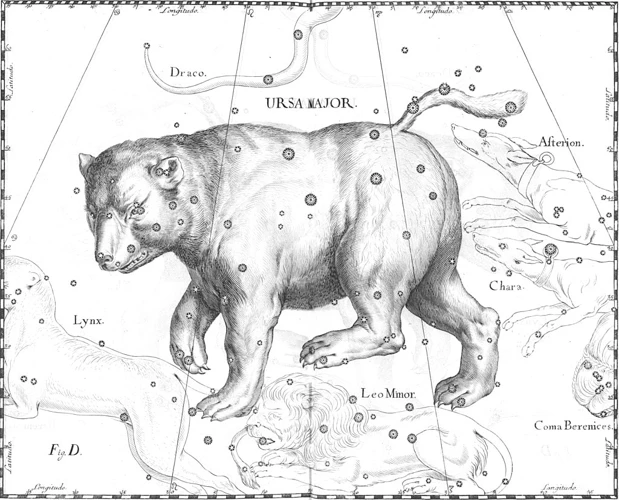
The history of Ursa Major can be traced back to ancient civilizations, where it held significant cultural and navigational value. One of the oldest records of Ursa Major dates back to ancient Mesopotamia, where it was associated with the celestial goddess Ishtar. In Greek mythology, Ursa Major is linked to the story of Callisto, a beautiful nymph who caught the attention of Zeus and was transformed into a bear by his jealous wife Hera. As the bear constellation, Ursa Major became a prominent figure in Greek folklore.
During the Age of Exploration, Ursa Major served as a guiding star constellation for sailors navigating the seas. The stars of the Big Dipper, which form part of Ursa Major, helped sailors in the Northern Hemisphere find their way. Even today, Ursa Major remains an important constellation for navigation and orientation. Its historical significance and enduring presence in human culture make it a subject of fascination and wonder. Beyond its navigational role, the constellation’s historical impact can be seen in art, literature, and even scientific research. The stories and symbolism surrounding Ursa Major continue to captivate the human imagination.
The Mythology behind Ursa Major
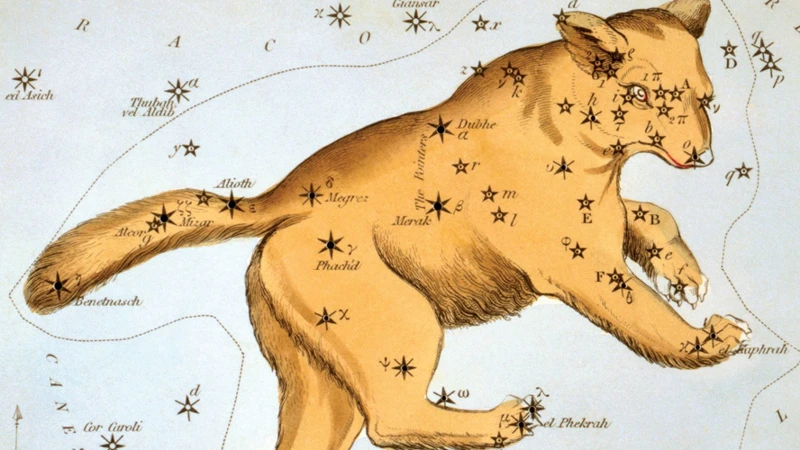
Ursa Major holds a rich mythology behind it, spanning across various cultures throughout history. In Greek mythology, Ursa Major is associated with the story of Callisto, a beautiful nymph who caught the attention of Zeus, the king of gods. However, their secret affair was discovered by Zeus’ jealous wife, Hera, who transformed Callisto into a bear as punishment. This transformed bear became Ursa Major, forever immortalized in the night sky. In Native American legends, Ursa Major is often portrayed as a bear pursued by hunters or representing a guardian spirit. Different cultures have their own unique interpretations of Ursa Major, tying it to tales of adventure, love, and spirituality. The constellation’s mythological significance continues to inspire artists, writers, and storytellers in capturing the allure and mystery of the night sky, allowing us to connect with ancient narratives that have stood the test of time.
1. The Greek Myth of Callisto
The Greek myth of Callisto is one of the most prominent stories associated with Ursa Major. According to the myth, Callisto was a beautiful nymph who caught the attention of Zeus, the king of the gods. Zeus, unable to resist his desires, disguised himself as Artemis, the goddess of the hunt, to get close to Callisto. However, Zeus’s actions did not go unnoticed by his wife, Hera. Out of jealousy, Hera discovered Callisto’s pregnancy and transformed her into a bear as punishment.
As a bear, Callisto roamed the forests, separated from her son Arcas. Years later, Arcas encountered her in the woods while hunting. Unaware that the bear was his mother, he aimed his spear at her. Zeus, filled with remorse and compassion, intervened and placed both Callisto and Arcas in the night sky as constellations – Ursa Major and Ursa Minor, respectively. The Greek myth of Callisto not only explains the origins of Ursa Major but also showcases the complex relationships and divine interventions in Greek mythology. The symbolic transformation of Callisto into the great bear immortalizes her story, maintaining its relevance and presence in our cultural consciousness.
2. The Native American Legends
Native American cultures also have fascinating legends surrounding Ursa Major. Among the many tribes, there are several unique stories that explain the presence of the Great Bear in the night sky. In one Native American legend, Ursa Major represents seven hunters who pursued a giant bear across the sky. The bear was believed to have caused a great flood, and the hunters were placed in the heavens by the Great Spirit as a reminder of their bravery and sacrifice. Each star within Ursa Major’s constellation symbolizes one of the hunters.
Another Native American legend tells of a hunter who was transformed into a bear and placed among the stars by the Great Spirit as a symbol of protection and guidance. In some tribes, Ursa Major is also associated with the changing seasons and acts as a celestial calendar. As the constellation revolves throughout the year, it marks the passage of time and the cyclical nature of life.
These Native American legends epitomize the spiritual connection between the sky and the earth. They demonstrate the reverence and respect that Indigenous cultures held for nature and the celestial bodies above. Ursa Major, with its prominent presence in the northern hemisphere, held great significance for navigation, storytelling, and spiritual beliefs among Native American tribes. Its inclusion in their mythologies highlights the deep cultural and historical value of this celestial constellation.
3. The Stories from Other Cultures
3. The Stories from Other Cultures
Apart from Greek mythology, Ursa Major holds significance in the stories and legends of various other cultures around the world. In Norse mythology, Ursa Major is associated with the god Thor, representing his chariot or wagon. In Native American folklore, the constellation is often seen as the Great Bear or the Big Bear, symbolizing strength and protection. The Lakota Sioux have a legend where Ursa Major represents a group of seven brothers who were transformed into stars to guide travelers at night. In Chinese mythology, the constellation is known as the Northern Dipper and is associated with the celestial god of longevity, Shou Xing. The Sami people of northern Europe believe that Ursa Major is a pathway for the spirits of their ancestors to travel across the sky. Each culture has its own unique interpretation and stories about Ursa Major, demonstrating the universal fascination with the stars and their cosmic tales. It is remarkable to witness how this constellation has found a place in the mythologies and folklore of diverse civilizations throughout history.
The Symbolism of Ursa Major
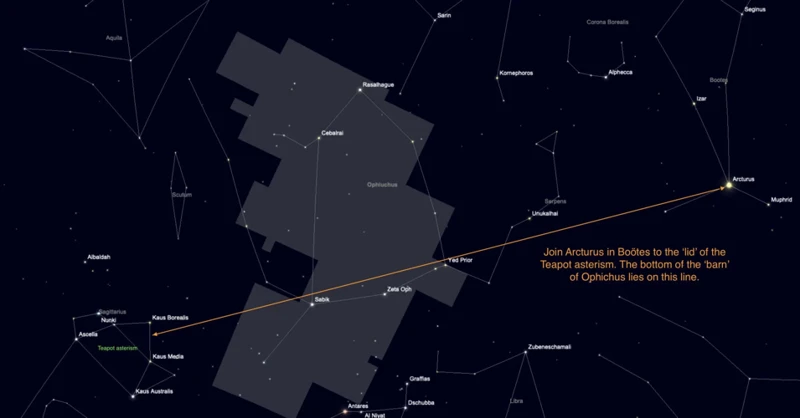
Ursa Major holds profound symbolism across different cultures and disciplines. As a symbol, the bear carries various meanings, including strength, protection, and wisdom. In different mythologies and folklore, the bear often represents a powerful and divine being, associated with deities and natural forces. In astrology, Ursa Major is linked to traits such as resourcefulness, determination, and leadership. The constellation’s prominence in the night sky has made it a significant celestial marker for navigation and orientation. Ursa Major’s symbolism extends beyond its individual stars to the shape of the constellation itself, resembling a bear. Its timeless significance has influenced art, literature, and even scientific research. Whether as a guiding star or a cultural emblem, Ursa Major continues to inspire and captivate individuals, inviting contemplation and exploration of its profound symbolism. [source]
1. The Bear as a Symbol in Different Cultures
The bear, as a symbol, holds significant cultural and spiritual meaning in various societies around the world. In Native American cultures, the bear symbolizes strength, courage, and healing. Tribes such as the Apache, Iroquois, and Haida have legends and rituals that pay homage to the bear’s power and wisdom. In Norse mythology, the bear represents the warrior spirit and is associated with the god Thor. The bear also plays a prominent role in East Asian cultures. In Chinese folklore, the celestial Bear Emperor is associated with the Ursa Major constellation and symbolizes power and honor. In Japanese mythology, the bear is revered as a divine creature and is believed to bring good luck and protection. Similarly, the Ainu people of Japan consider the bear as a spiritual guardian. The bear’s symbolism extends beyond these cultures, capturing the collective human fascination with its attributes of courage, resilience, and protection. This symbolism is deeply ingrained in the mythological and cultural narratives across different civilizations, connecting humanity through the enduring symbol of the bear. (Source: [link])
2. The Significance of Ursa Major in Astrology
The Significance of Ursa Major in Astrology
In the realm of astrology, Ursa Major holds a special place. The constellation and its prominent stars have been associated with various astrological interpretations and beliefs. One of the most significant aspects of Ursa Major in astrology is its connection to the concept of the North Star, Polaris. Polaris is approximately aligned with the Earth’s axis of rotation and remains relatively fixed in the night sky, serving as a guiding light. This stability and guiding function are often attributed to the qualities of Ursa Major in astrological readings.
Ursa Major is symbolically linked to strength, power, and stability in astrology. Those born under the influence of this constellation are said to possess a determined and reliable nature. They are often seen as natural leaders and are known for their ability to provide stability and guidance to others. The presence of Ursa Major in a natal chart is believed to enhance one’s grounded nature and provide a sense of direction in life. It is also associated with qualities such as resilience, protection, and steadfastness.
Astrologers also believe that Ursa Major can influence relationships and emotions. People with a strong Ursa Major presence in their birth chart are thought to be nurturing individuals who value stability and security in their connections. They seek long-lasting relationships built on trust and loyalty. The bear symbolism of Ursa Major further emphasizes their protective and caring nature.
It is important to note that the interpretations and significance of Ursa Major in astrology may vary among different astrological traditions and practitioners. However, its enduring presence in astrological discourse indicates the deep-rooted belief in its transformative and guiding influences. If you’re interested in exploring your own astrological traits, you can consult a professional astrologer or research more about the significance of natal charts in astrology.
The Astronomical Facts of Ursa Major
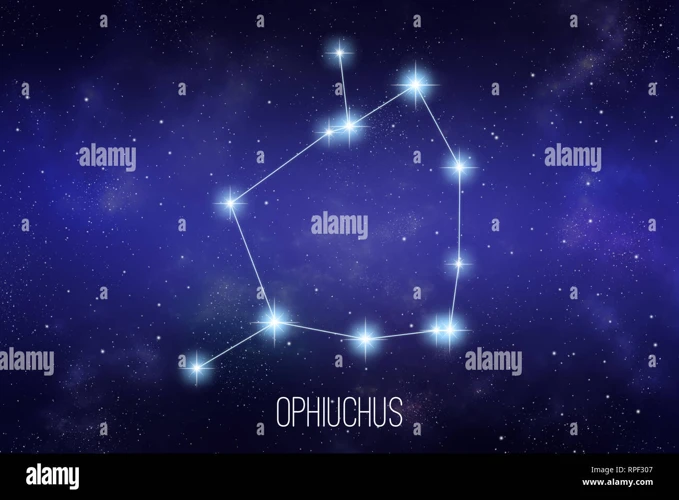
The astronomical facts of Ursa Major shed light on the constellation’s fascinating characteristics. Ursa Major is home to some of the brightest stars in the night sky, with seven prominent stars making up the Big Dipper asterism. These stars are named Alkaid, Mizar, Alioth, Megrez, Phecda, Merak, and Dubhe. They form a distinct shape resembling a ladle or a plow, which has been recognized and utilized by various cultures throughout history. Ursa Major is located in the northern celestial hemisphere and is visible year-round from most parts of the Northern Hemisphere. Its prominent position and easy identification make it a popular starting point for stargazers and astronomers. Ursa Major has been the subject of extensive scientific research, including studies on dark matter halos and the structure of galaxies. Its celestial significance continues to intrigue and inspire scientists and enthusiasts alike.
1. The Seven Brightest Stars of Ursa Major
The constellation Ursa Major is renowned for its seven brightest stars, which form the iconic Big Dipper asterism. These stars, also known as the “Plough” in British English, are easily recognizable and have captivated stargazers for centuries. The seven stars are individually named as follows:
1. Dubhe: The brightest star in Ursa Major, Dubhe is a giant star located approximately 123 light-years away from Earth. Its name originates from the Arabic word for “bear.”
2. Merak: Sitting next to Dubhe, Merak is another giant star, slightly fainter than Dubhe. It derives its name from an Arabic term meaning “loin” or “hip of the bear.”
3. Phecda: Found at the base of the Big Dipper’s handle, Phecda is a blue-white star located around 84 light-years away from our planet. Its name is derived from the Arabic words for “thigh of the bear.”
4. Megrez: Positioned between Phecda and Dubhe, Megrez holds the distinction of being the faintest of the seven bright stars. Its name comes from an Arabic term meaning “root” or “base.”
5. Alioth: As the third brightest star in Ursa Major, Alioth shines with a white light that stands out against the night sky. It is located around 81 light-years away. The name Alioth has Arabic origins and means “fat tail of a sheep” or “black sheep.”
6. Mizar: Mizar, which means “loin cloth” in Arabic, is a famous double star within the constellation. Through a telescope, stargazers can spot a companion star, Alcor, located close to it.
7. Alkaid: Situated at the end of the Big Dipper’s handle, Alkaid is the farthest star among the seven bright stars of Ursa Major. Its name is derived from the Arabic term for “tail.”
These seven stars not only provide a striking visual sight but also serve as navigational aids and points of interest for astronomers and stargazers alike. Observing these celestial gems can be a starting point for further exploration and appreciation of the wonders of our universe.
2. The Location and Visibility of Ursa Major in the Night Sky
2. The Location and Visibility of Ursa Major in the Night Sky
Ursa Major is a circumpolar constellation, meaning it can be seen year-round in the Northern Hemisphere. Its position in the night sky makes it easily recognizable and a popular sight for stargazers. To locate Ursa Major, one can first look for the easily identifiable Big Dipper, which is part of the larger constellation. The Big Dipper is characterized by its seven bright stars that form the shape of a ladle or saucepan. These stars, known as the “pointer stars,” can be used to find the North Star, Polaris. By drawing an imaginary line through the two outermost stars of the Big Dipper’s bowl and extending it five times the distance between them, one can find Polaris, which lies in the constellation Ursa Minor, the Little Bear. Ursa Major itself is located adjacent to Ursa Minor, with its head facing towards the Little Bear.
The visibility of Ursa Major varies throughout the year due to the rotation of Earth. During the spring and summer months, Ursa Major is more prominent in the evening sky, as it is visible in the northern direction for longer periods. In contrast, during the fall and winter months, Ursa Major is visible during the early evening hours, moving closer to the western horizon as the night progresses. Its position near the celestial north pole ensures that Ursa Major never sets below the horizon, making it a constant presence in the night sky. The accessibility and visibility of Ursa Major have made it a beloved and easily recognizable constellation throughout history.
Discovering the Constellation’s Shape and Features
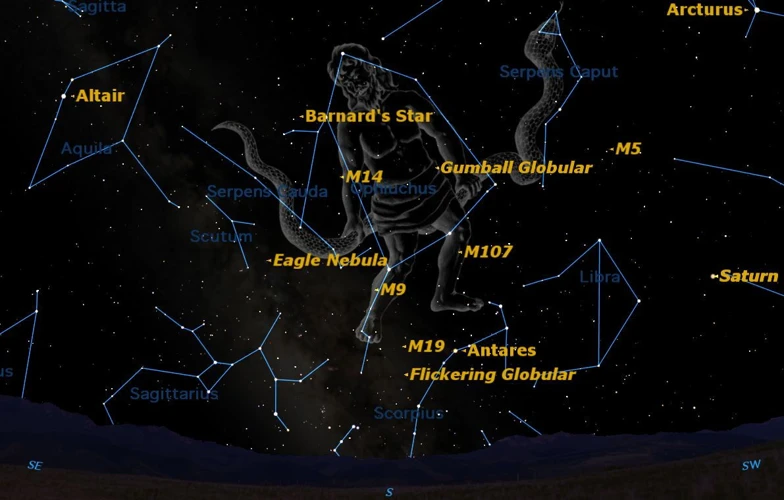
Discovering the Constellation’s Shape and Features:
Ursa Major is easily recognizable due to its distinctive shape, resembling a great bear. The constellation is composed of several prominent stars, forming an asterism called the Big Dipper or the Plough. The Big Dipper consists of seven stars, with three forming the handle and four outlining the bear’s body. These stars are named after their positions within the constellation: Alkaid, Mizar, Alioth, Megrez, Phecda, Merak, and Dubhe. Mizar, the second star in the handle, is particularly intriguing as it is a double star system, visible even with the naked eye. Astronomers have also discovered that Dubhe and Alkaid have their own companion stars, making Ursa Major a fascinating cluster of stellar arrangements. The constellation’s outline can be traced by connecting these stars, leading to the realization that Ursa Major is indeed a bear. Its notable size and visibility in the night sky make it a popular target for stargazers and astronomers alike, offering a captivating sight that has inspired countless imaginations throughout history.
Ursa Major and Ursa Minor: The Great Bear and the Little Bear
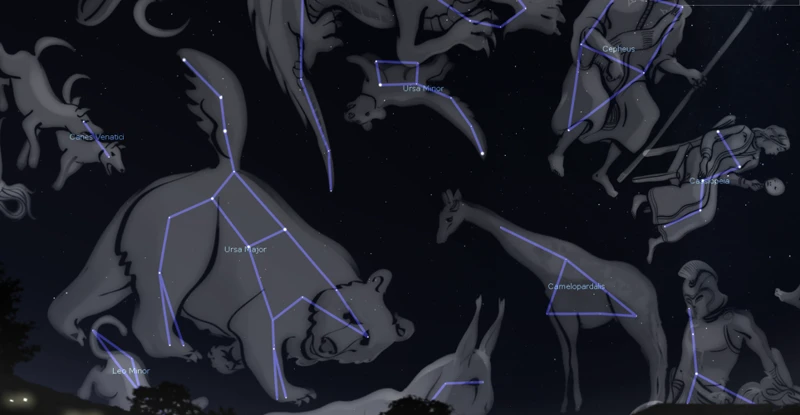
Ursa Major and Ursa Minor are two prominent constellations that have long been associated with each other in mythology and astronomy. In Greek mythology, Ursa Major represents the Great Bear, while Ursa Minor symbolizes the Little Bear. According to the myth, Zeus transformed Callisto, a beautiful nymph, into a bear, which became Ursa Major. Ursa Minor, on the other hand, is associated with Arcas, the son of Callisto, who was also transformed into a bear and became Ursa Minor.
These two constellations are often depicted together in various cultural depictions and have served as important navigational tools throughout history. Ursa Major contains the prominent asterism known as the Big Dipper, which is easily recognizable and has been used by sailors and travelers as a guiding point in the night sky. Ursa Minor is home to the North Star, also known as Polaris, which has been used by navigators to determine their latitude.
The relationship between Ursa Major and Ursa Minor goes beyond their proximity in the night sky. They are intertwined in mythology, astronomy, and even in astrology. In astrology, Ursa Major and Ursa Minor are associated with different zodiac signs and have their own unique interpretations and traits. Understanding the connection between these two constellations enriches our appreciation for the celestial wonders that grace our night sky.
The Depictions of Ursa Major in Art and Literature
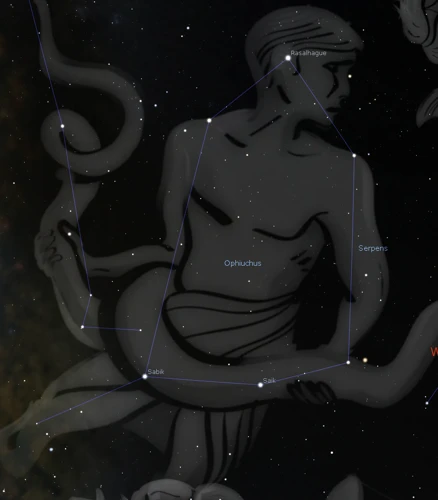
The depiction of Ursa Major in art and literature is a testament to its enduring presence and significance in human culture. In ancient times, the constellation found its way onto various celestial globes, where it was represented as a bear or a wagon. The bear motif also permeated classical mythology, where Ursa Major often symbolized strength, power, and protection. In art, Ursa Major has been portrayed in numerous paintings and sculptures, with notable examples including “The Great Bear” by Peter Paul Rubens and “Ursa Major” by Charles Émile Jacque. In literature, Ursa Major has made appearances in works such as Dante’s “The Divine Comedy” and Shakespeare’s “A Midsummer Night’s Dream.” Its depiction as a celestial guide, guardian, and mythical figure adds depth and symbolism to these creative expressions. The influence of Ursa Major can also be seen in modern literature and popular culture, where it continues to inspire and captivate audiences with its majestic presence.
The Cultural References and Influences of Ursa Major
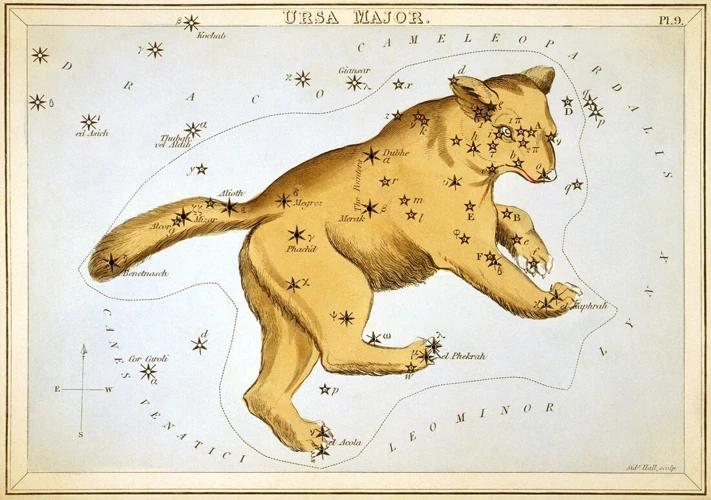
The cultural references and influences of Ursa Major can be seen across various civilizations and artistic disciplines. In ancient Greek and Roman mythology, the constellation holds a prominent place through the story of Callisto and her transformation into a bear. It has also been associated with the goddess Artemis, known as the protector of wild animals. This connection to bears is not limited to Greek mythology alone, as Native American legends also feature bears prominently. For example, the Lakota Sioux tribe sees Ursa Major as a celestial bear of great spiritual significance. This cultural reference highlights the universal symbolism attributed to bears across different cultures, where they are often considered powerful and wise creatures. In astrology, Ursa Major holds influence as well. Astrologers believe that the constellation’s position during birth can have an impact on an individual’s personality and traits. Further, Ursa Major’s role in navigation throughout history has influenced the exploration of new territories. An example of this is the fall of the Aztec Empire at the hands of Hernán Cortés, who navigated his way using the constellation. These cultural references and influences demonstrate the enduring presence of Ursa Major as a source of inspiration and meaning for humanity.
Interpretations and Modern Significance of Ursa Major
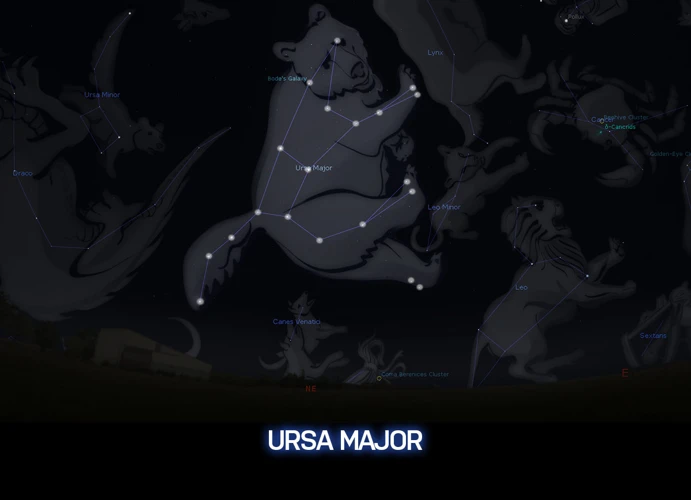
Interpretations and Modern Significance of Ursa Major
Ursa Major continues to hold a significant place in contemporary culture and has been subject to various interpretations. In astrology, Ursa Major is seen as representing strength, stability, and protection. Its connection to the Greek myth of Callisto and transformation also emphasizes the theme of personal growth and evolution. The constellation’s prominence in popular media, such as books, movies, and video games, showcases its enduring appeal and influence. Additionally, Ursa Major’s depiction in art and literature throughout history reflects its universal symbolism and timeless allure. Today, many people find comfort and inspiration in the stories and symbolism of Ursa Major, whether they explore its astrological significance in natal charts or simply marvel at its grandeur in the night sky. The modern understanding and interpretation of Ursa Major continue to weave its way into our lives, reminding us of the enduring legacy and impact of this majestic constellation.
1. Exploration of Constellation Symbolism in Contemporary Culture
In contemporary culture, the exploration of constellation symbolism holds a special place. Ursa Major, with its iconic shape and rich history, has become a source of inspiration in various fields. In art and design, the bear constellation often represents strength, courage, and protection. Its timeless appeal is often incorporated into jewelry, tattoos, and decorative pieces.
In literature and storytelling, Ursa Major is frequently referenced as a symbol of guidance and resilience. It serves as a metaphor for finding one’s way through challenges and navigating life’s journey. This symbolism is particularly relevant in coming-of-age narratives and self-discovery themes.
In the realm of astrology, Ursa Major holds significance for those looking to understand their zodiac signs and natal charts. The constellation’s position and alignment with other celestial bodies can offer insights into personality traits, strengths, and challenges. Ursa Major’s symbolism intertwines with astrological interpretations and adds depth to the astrological landscape.
Ursa Major’s symbolism can be seen in popular cultural references, such as movies, music, and even video games. Its presence in these mediums often adds a touch of mystique, adventure, and wonder. The enduring fascination with Ursa Major in contemporary culture showcases its timeless appeal and the enduring allure of constellation symbolism.
Learn more: To explore how constellations and symbolism played a crucial role in the fall of the Aztec Empire, read about the encounter between Hernán Cortés and Montezuma II in “The Fall of the Aztec Empire: Cortés and the Conquest of Mexico”[internal link]. This fascinating historical event sheds light on the cultural significance of constellations during this era [anchor link].
2. The Fascination with Ursa Major in Popular Media
2. The Fascination with Ursa Major in Popular Media
Ursa Major’s enchanting presence in the night sky has sparked the imagination of popular media creators, leading to its depiction in various forms of entertainment. From literature to film and even music, Ursa Major often takes center stage as a symbol of strength, guidance, and adventure. In literature, we see Ursa Major mentioned in works such as J.R.R. Tolkien’s “The Hobbit,” where it is referenced as the “Big Bear” and serves as a navigational point for Bilbo Baggins on his journey. The constellation has also made appearances in films like “Brother Bear,” where it becomes a transformative symbol in the protagonist’s quest for self-discovery. Its iconic shape and symbolism have even found their way into popular music, with songs like Elton John’s “Rocket Man” referencing the constellation as a symbol of exploration and space travel. The fascination with Ursa Major in popular media exemplifies its enduring allure and the profound impact it has on human creativity. The stories and symbolism associated with the Great Bear continue to inspire and captivate audiences across different mediums.
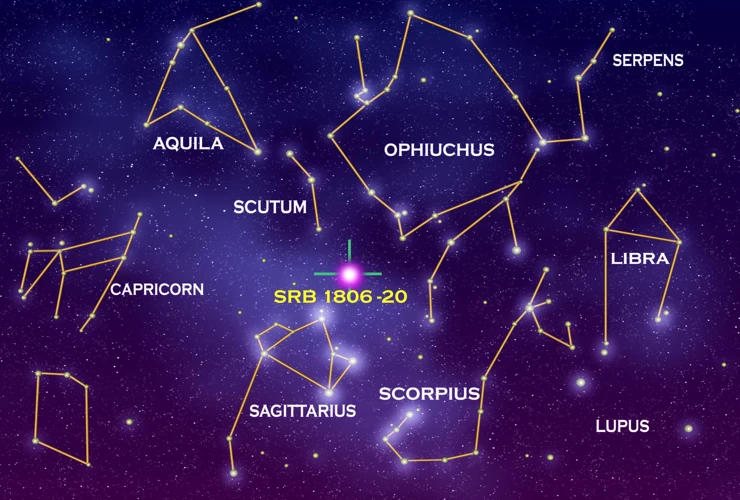
The scientific research and discoveries related to Ursa Major have contributed significantly to our understanding of the universe. Astronomers have studied this constellation and its stars to unravel the mysteries of stellar evolution, galaxy formation, and dark matter. One notable discovery linked to Ursa Major is the identification of Mizar and Alcor as a visual binary star system. These stars were among the first to be recognized as binary systems, providing valuable insights into the nature of multiple star systems. Additionally, Ursa Major has played a crucial role in the study of galaxy clusters and large-scale structures in the universe. The Virgo Supercluster, which includes our Milky Way galaxy, is gravitationally influenced by the presence of Ursa Major. This knowledge has contributed to our understanding of cosmic filaments and the large-scale distribution of galaxies. Ongoing research continues to unravel the intricacies of Ursa Major’s celestial elements, shedding light on the fundamental workings of the universe. (Link: /fall-of-aztec-empire-cortes/)
The Importance and Impact of Ursa Major on Astronomy
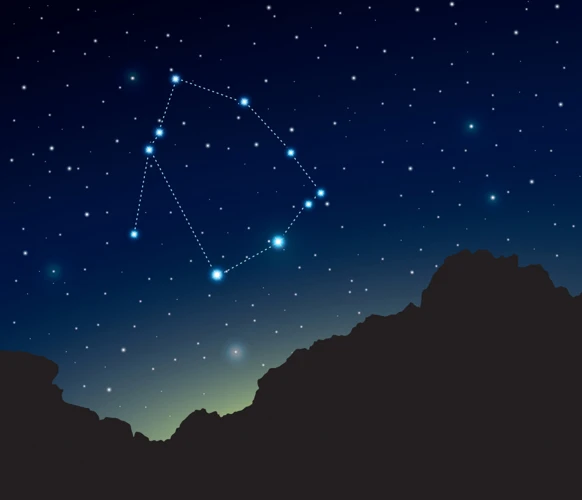
The Importance and Impact of Ursa Major on Astronomy
1. Celestial Navigation: Ursa Major has played a crucial role in celestial navigation throughout history. Its prominent position in the northern sky and the easily recognizable shape of the Big Dipper have been used for orientation and finding the North Star, Polaris. This has aided navigators, astronomers, and explorers in determining their latitude and direction.
2. Motion of Stars: Ursa Major has contributed to our understanding of stellar motion. The stars in this constellation, along with Ursa Minor, have been used as reference points to study the proper motion of stars relative to the Earth. This has helped astronomers in mapping the movements and trajectories of numerous celestial objects.
3. Galaxy Structures: Ursa Major has influenced our knowledge of galaxy structures. Within this constellation lies the Ursa Major Cluster, a group of galaxies that includes the well-known Messier 81 and Messier 82. Studying these galaxies has expanded our understanding of galactic formation, evolution, and interactions.
4. Dark Matter Halo Discovery: Ursa Major has played a role in unraveling the mystery of dark matter. Scientists have observed the rotation curves of galaxies within this constellation, which suggest the presence of a dark matter halo surrounding these galaxies. This discovery has shed light on the existence and distribution of dark matter in the universe.
5. Stellar Evolution: Ursa Major has provided a platform for studying stellar evolution. Many stars within the constellation have been analyzed to understand various stages of stellar lifecycles, from protostars to main sequence stars, red giants, and even supernovae. This research has deepened our knowledge of stellar evolution and the processes that drive it.
6. Astronomical Education: Ursa Major has served as an excellent entry point for people interested in astronomy. Its recognizable shape and prominent location have made it a popular target for stargazers and amateur astronomers. Exploring the stars of Ursa Major has allowed beginners to learn about constellation identification and star hopping techniques.
7. Space Missions and Research: The constellation Ursa Major has also inspired space missions and research projects. Numerous spacecraft and observatories, such as the Hubble Space Telescope, have captured stunning images and collected valuable data from objects within this constellation. These missions have enriched our understanding of the universe and expanded our knowledge of Ursa Major’s celestial inhabitants.
The impact of Ursa Major on astronomy is far-reaching and multifaceted. From aiding navigation to uncovering the mysteries of the universe, this constellation continues to shape our understanding of the cosmos. Its significance will undoubtedly persist as we further explore and study the vast expanse of space.
Unveiling the Mystery of Ursa Major’s Dark Matter Halo
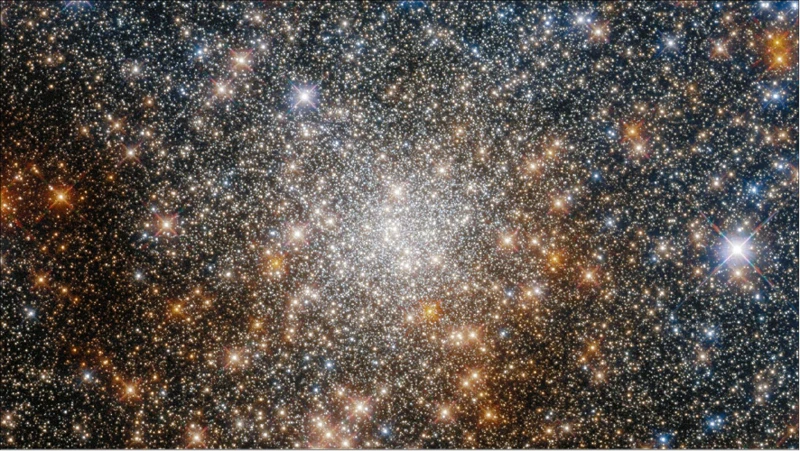
The mystery of Ursa Major’s dark matter halo has puzzled scientists for years. Dark matter is a form of matter that does not interact with light or other electromagnetic radiation, making it invisible to traditional detection methods. However, its presence can be inferred through its gravitational effects on visible matter. Astronomers believe that galaxies, including Ursa Major, are surrounded by massive halos of dark matter that play a crucial role in shaping the structure and dynamics of these stellar systems. By studying the motion of stars within Ursa Major, scientists have been able to estimate the amount and distribution of dark matter in its halo. They have found that the dark matter halo of Ursa Major extends far beyond the visible boundaries of the galaxy, indicating the presence of significant unseen mass. The exact nature and composition of dark matter remain elusive, but ongoing research and observations continue to shed light on this enigmatic phenomenon. Understanding the dark matter halo of Ursa Major is not only important for unraveling the mysteries of our own galaxy but also for advancing our knowledge of the universe as a whole. Through innovative technologies and collaborative efforts, scientists are inching closer to uncovering the secrets of Ursa Major’s dark matter halo and its implications for our understanding of cosmic evolution.
Conclusion

In conclusion, the constellation Ursa Major holds a wealth of history, mythology, and symbolism. It has been a source of inspiration and wonder for countless generations, captivating the imaginations of people from different cultures and time periods. From the ancient Greeks and their myth of Callisto to the navigational significance of Ursa Major for sailors, this constellation has left an indelible mark on human civilization. Its depiction in art, literature, and popular culture further reinforce its enduring presence in our collective consciousness. Additionally, Ursa Major’s astronomical facts and features, such as its seven brightest stars and its visibility in the night sky, offer fascinating insights for both astronomers and stargazers. Whether it be exploring its shape and depictions, uncovering its cultural references and influences, or delving into its modern interpretations, Ursa Major continues to captivate and intrigue us. As we continue to gaze at the stars, Ursa Major will remain a celestial wonder that enchants and inspires us.
Frequently Asked Questions

1. What is Ursa Major’s significance in ancient mythology?
Ursa Major holds great significance in ancient mythology, particularly in Greek and Native American cultures. In Greek mythology, it is associated with the story of Callisto, a nymph who was transformed into a bear. In Native American legends, Ursa Major represents bears that played important roles in tribal folklore and spiritual beliefs.
2. How did Ursa Major assist sailors during the Age of Exploration?
During the Age of Exploration, Ursa Major provided a navigational guide for sailors in the Northern Hemisphere. Its prominent formation, particularly the stars of the Big Dipper, helped sailors find their way and determine their latitude, making it an invaluable celestial tool for navigation.
3. What is the significance of Ursa Major in astrology?
Ursa Major holds astrological significance, representing strength, power, and protection. It is associated with characteristics such as leadership, determination, and resilience. Some astrologers believe that individuals born under Ursa Major’s influence possess a strong connection to nature and an inclination towards leadership roles.
/the-significance-of-natal-charts-in-astrology/
4. How can Ursa Major be located in the night sky?
Ursa Major is easily located in the night sky due to its distinctive shape. Look for the Big Dipper, which is part of Ursa Major. The Big Dipper resembles a large ladle or spoon and is often used as a reference point for finding other constellations in the sky.
5. What are the seven brightest stars in Ursa Major?
The seven brightest stars of Ursa Major, known as the Big Dipper, are Dubhe, Merak, Phecda, Megrez, Alioth, Mizar, and Alkaid. These stars form the unmistakable shape of the Big Dipper and serve as a prominent feature of Ursa Major.
6. How does Ursa Major differ from Ursa Minor?
Ursa Major and Ursa Minor are both bear constellations, but they have distinct differences. Ursa Major is the Great Bear and contains the recognizable pattern of the Big Dipper. Ursa Minor, on the other hand, is the Little Bear and is best known for its most famous star, Polaris, also known as the North Star.
7. What are some notable cultural references to Ursa Major?
Ursa Major has made its mark in various cultural references, including art and literature. It is often seen in ancient cave paintings, depicting its significance in early human cultures. In literature, Ursa Major has been featured in works such as Dante’s “Divine Comedy” and Shakespeare’s “King Lear.”
8. What are the modern interpretations and significance of Ursa Major?
Today, Ursa Major continues to captivate our imagination and hold symbolism in contemporary culture. Its image is often used in logos and branding to convey strength and power. Additionally, Ursa Major’s symbolisms are explored in astrology and spiritual practices, further deepening its significance in modern times.
9. How has scientific research contributed to our understanding of Ursa Major?
Scientific research has played a crucial role in expanding our knowledge of Ursa Major. Astronomers have studied the composition, movement, and evolutionary stages of its stars, contributing to our understanding of stellar formation and the universe at large. Additionally, ongoing research sheds light on the dark matter halo surrounding Ursa Major.
10. What impact has Ursa Major had on the field of astronomy?
Ursa Major has had a significant impact on the field of astronomy. Its visibility and recognizable pattern have made it an essential constellation for navigation and orientation in the night sky. Additionally, Ursa Major has served as a guide for astronomers in studying other celestial bodies and expanding our knowledge of the universe.
References
Frequently Asked Questions

1. What is the significance of Ursa Major in astrology?
Ursa Major holds great significance in astrology as it is believed to represent power, strength, and courage. It is often associated with qualities like leadership and protection.
2. How can I locate Ursa Major in the night sky?
Locating Ursa Major in the night sky is fairly simple. Look for the Big Dipper, which is part of the constellation. The Big Dipper’s handle points towards the North Star, making it a useful navigational tool.
3. What are the stories behind Ursa Major in Native American legends?
In Native American legends, Ursa Major is often associated with creation stories and has different interpretations across various tribes. Some stories link the constellation to the bear’s role as a protector and guide in the celestial realm.
4. How many bright stars are there in Ursa Major?
Ursa Major is home to seven bright stars, which are also known as the Big Dipper. These stars are Alkaid, Mizar, Alioth, Megrez, Phecda, Merak, and Dubhe.
5. What is the myth of Callisto and its connection to Ursa Major?
In Greek mythology, Callisto was a beautiful nymph who caught the attention of Zeus. Hera, Zeus’ wife, turned Callisto into a bear out of jealousy. Eventually, Callisto was placed in the sky by Zeus, forming the constellation Ursa Major.
6. How is Ursa Major depicted in art and literature?
Ursa Major has been depicted in various artistic forms throughout history. It has been portrayed in paintings, sculptures, and even mentioned in famous literary works like Shakespeare’s “A Midsummer Night’s Dream.”
7. What is the cultural influence of Ursa Major?
Ursa Major holds cultural significance across different societies. It has been revered as a spiritual symbol, representing strength, guidance, and wisdom. Many cultures have incorporated the constellation into their folklore and traditions.
8. What is the role of Ursa Major in contemporary culture?
In contemporary culture, Ursa Major’s symbolism is often explored in artistic and mystical contexts. It is seen in tattoo designs, jewelry, and even clothing. The constellation continues to captivate the imagination of people today.
Scientists have made significant discoveries related to Ursa Major. It has been studied extensively to understand the formation and evolution of galaxies. Additionally, research has been conducted to unravel the mysteries of the dark matter halo surrounding the constellation.
10. How does Ursa Major impact astronomy?
Ursa Major plays a vital role in astronomy. It serves as a guide for astronomers to locate other celestial objects in the sky. Its visibility and easily recognizable shape make it a reference point for stargazers and researchers alike.







